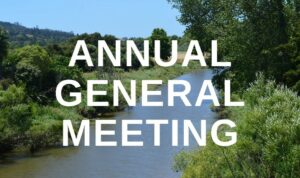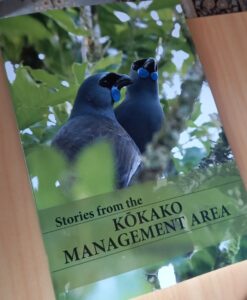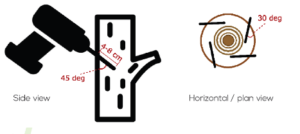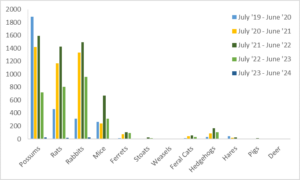Kia ora to all Friends of the Wairoa River Catchment!
There are many new recipients of this newsletter – welcome! We have recently merged two separate mailing lists. One was minimally used, so has been brought over to this platform. Hopefully, you’ll find the 5 newsletters per year from us of interest! We cover a variety of conservation-based topics and various local upcoming events and workshops to help you on your journey – after all, if our goal is to restore the mauri of the Wairoa River, all of us have a part to play and we should play to our strengths.
If you are not interested in receiving these emails, or you have moved out of the area, please feel free to use the unsubscribe button at the bottom of this email. But we do hope you stick around!

Wednesday 20th September
Hūnua Hall, 6pm
Food and drink provided – please RSVP via info@tewairoa.org.nz for catering purposes
James Talbot from WaterCare will be speaking about the felling of pine forests in the Hūnua Ranges and their replacement with native plants, protecting the Auckland water resource and enhancing local biodiversity and habitat.
You’ll also have a chance to hear about what we’ve been up to and what we’re planning for the coming year. All are welcome to attend, and in particular we welcome anyone interested in joining us on the committee.
If you want to know a bit more about our local conservation history, order a copy of the recently published book ‘Stories from the Kōkako Management Area’ by our very own Lenny van Heugten. This book follows the decline and then the growth in the kōkako population in the Hūnua Ranges, and the stories of those involved in the project over the years, including many familiar local names and faces.
Books are $35 to purchase from www.friendsofhunuaranges.co.nz. Profits will be used by our mates, Friends of Hūnua Ranges, to continue to enhance the Hūnua Ranges for future generations of plants, animals and people.

Willows… not the human kind, which is arguably benefitting the environment (if you know you know!), but the tree-type…
We’re working on a plan to eradicate crack willows along the Wairoa River. Willows contribute to blockages and flooding, and broken branches will easily root in river banks downstream. You can help us by beginning to control some of the more manageable trees on your property, or offering to help your neighbours.
The best method is to drill holes in the trunk and fill with undiluted glyphosate. This will only be effective during active growing months, September to February. The number of holes to drill and fill with depends on the width of the trunk at shoulder height. Each branch should be treated as a separate tree.
| Width (cm) | 10-20 | 25 | 35 | 50 | 80 | 100-110 | 120 | 125 | 135 | 140 | 160 |
| # of holes | 1 | 2 | 3 | 4 | 6 | 8 | 9 | 10 | 11 | 12 | 13 |
Using a 6 – 10mm drill bit, make holes 4 – 8cm deep, evenly spaced as near to the ground as possible and into prominent roots, on a 45° downward angle and 30° inward towards the centre. The hole should be just deep enough to contain 10ml of herbicide.

Apply glyphosate immediately after drilling, filling the hole to the edge to ensure uptake by the tree in the active outer layers. Use something like a drenching gun or sauce bottle with a longer nozzle and a cap to seal it. Ensure you label your vessel clearly as used for herbicide. Plugging holes after filling is unnecessary as the hole is drilled at a downward angle.
This method will kill the trees and leave them standing – a great way to maintain bank stability while new plants establish underneath, but poses a danger where branches may fall. Use your best judgement in this case.
For skinnier trees where drilling won’t work, you can frill the tree and paste with glyphosate gel. Cut in the tree and pasting the stump is ineffective as cut branches and debris are likely to grow roots and form new trees, including from mulch.
In predator control news…
Friends of Te Wairoa have been working hard with landowners to get mammalian predators in our area under control, and we’re making some significant headway! We currently have 20% of landowners in the Wairoa River catchment area trapping and on our database, and residents have reported over 16,000 predators trapped in the past four years. This is an outstanding achievement, and our next goal is to strengthen the halo around the Hūnua Ranges to protect our taonga species that reside in the forest, including the kōkako and our long-tailed bats.
Please contact pestcontrol@tewairoa.org.nz if:
- You need predator control gear (bait, bait stations and traps) to get started on your property
- You have an existing programme in place but want a visit to review whether you’re on the right track
A massive thankyou to those who are regularly reporting catch tallies via the trap.nz app and email. It really helps to efficiently keep track of what’s happening out there. If you haven’t already, try signing up to trap.nz and join the Friends of Te Wairoa project. We can arrange a 1 – 1 tutorial on the use of the app if needed.

If predator control is getting on top of you, you’re finding it hard to keep up, or struggling with the size of your property, there is help which you can access for free. Predator Free Franklin have been recipient of a significant amount of funding via the Department of Conservation’s Jobs For Nature programme. With this money, local rangatahi have been recruited to aid landowners in their predator control efforts across the Franklin area. If you would like to enquire as to whether your property may be a candidate for support, please email the programme manager Colin Pukeiti at colin.pukeiti@tearahikoi.nz.
Finally, we’d like to thank you all for your ongoing support of the mahi we do. It’s what keeps that ball rolling forward.
Happy trapping,
Lenny van Heugten
Communications and Predator Control Co-ordinator
Friends of Te Wairoa
pestcontrol@tewairoa.org.nz